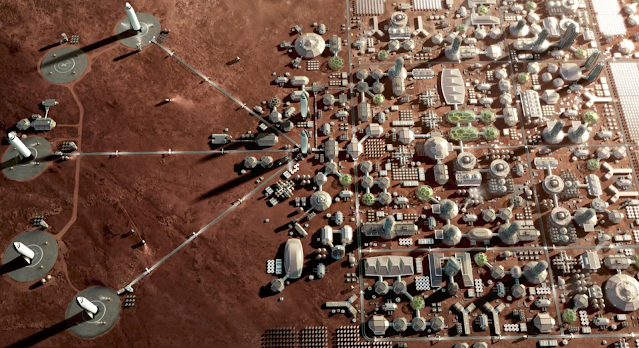 |
| © Provided by Geekwire An artist's conception shows a city taking shape on Mars. (SpaceX Illustration) |
Since its inception, science fiction has served as a platform from which to speculate about the future, investigate uncharted territory, and pose profound questions about the world as we know it. Terraforming, the process of making a previously uninhabitable planet or environment more suitable for human habitation, is an issue that has long captivated science fiction authors. This article will analyze how science fiction depicts terraforming and cities in the future, with a focus on the crucial role that cities play in these narratives.
In Science Fiction, Terraforming Is Often Used To
Numerous science fiction books have dealt with the topic of terraforming because of its widespread interest among science fiction readers. From Isaac Asimov's "Foundation" novels to Christopher Nolan's "Interstellar" and "Ad Astra," terraforming is a fascinating topic that appears in a wide range of science fiction works. The benefits and drawbacks of terraforming are frequently discussed in science fiction, as are the inherent difficulties and moral quandaries that arise from the practice. They picture a distant future in which humans use cutting-edge technology to transform uninhabitable planets into habitable ones through a process known as terraforming.
Future Urban Areas:
The portrayal of futuristic cities is another subgenre of science fiction that frequently overlaps with terraforming. Cities on newly terraformed planets are a common subject of science fiction, with authors pondering the perils and rewards of colonizing uncharted territory. These visualizations frequently offer a provocative glimpse into the potential ramifications of existing city planning and design on future urban development.
Impacts of Terraforming on Urban Areas:
Speculative fiction's examination of the link between terraforming and urbanization can shed light on real-world debates about how to make cities more sustainable. A common theme in science fiction is the idea that terraforming and city planning are intertwined, and that together they can produce more habitable worlds for the next generation. It prompts contemplation on the moral dimensions of urbanization and terraforming, as well as their potential effects on the environment.
Conclusion:
Finally, science fiction offers an intriguing perspective from which to examine the potential outcomes of terraforming on urban areas. It enables us to think ahead to the problems and opportunities that lie ahead, as well as evaluate new options. A better grasp of the consequences of terraforming and urbanization, as well as their possible impact on our globe, can be gained by analyzing how science fiction depicts their future. These are vital things to ask, and the discourse about terraforming and cities in the future, as well as the impact science fiction can have on how we view and approach these issues, must continue. It would be foolish to discount the influence of science fiction on our thoughts and practices about terraforming and urban planning.

